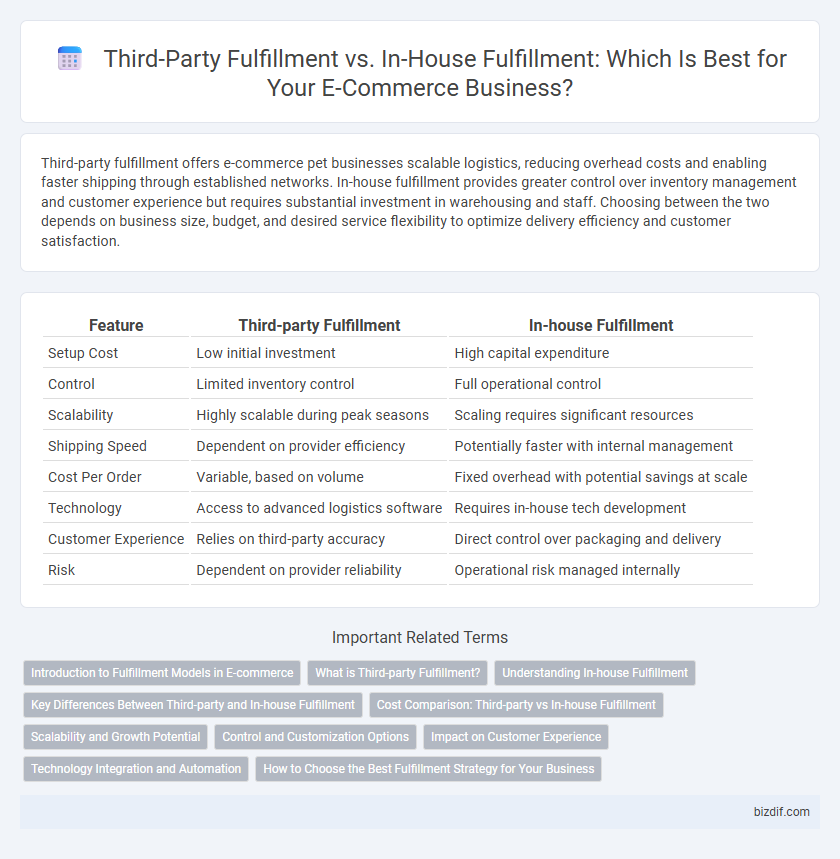Third-party fulfillment offers e-commerce pet businesses scalable logistics, reducing overhead costs and enabling faster shipping through established networks. In-house fulfillment provides greater control over inventory management and customer experience but requires substantial investment in warehousing and staff. Choosing between the two depends on business size, budget, and desired service flexibility to optimize delivery efficiency and customer satisfaction.
Table of Comparison
| Feature | Third-party Fulfillment | In-house Fulfillment |
|---|---|---|
| Setup Cost | Low initial investment | High capital expenditure |
| Control | Limited inventory control | Full operational control |
| Scalability | Highly scalable during peak seasons | Scaling requires significant resources |
| Shipping Speed | Dependent on provider efficiency | Potentially faster with internal management |
| Cost Per Order | Variable, based on volume | Fixed overhead with potential savings at scale |
| Technology | Access to advanced logistics software | Requires in-house tech development |
| Customer Experience | Relies on third-party accuracy | Direct control over packaging and delivery |
| Risk | Dependent on provider reliability | Operational risk managed internally |
Introduction to Fulfillment Models in E-commerce
Third-party fulfillment involves outsourcing warehousing, packing, and shipping to specialized service providers, enabling e-commerce businesses to scale operations without investing in infrastructure. In-house fulfillment requires managing inventory, order processing, and delivery logistics internally, offering greater control but higher overhead costs. Choosing the right fulfillment model impacts order accuracy, delivery speed, customer satisfaction, and overall operational efficiency in e-commerce.
What is Third-party Fulfillment?
Third-party fulfillment is a service where an external company manages the storage, packaging, and shipping of products on behalf of an e-commerce business. This approach allows online retailers to outsource inventory management and order fulfillment, leveraging the third party's warehousing infrastructure and logistics expertise. Utilizing third-party fulfillment can improve scalability, reduce overhead costs, and enhance delivery speed for e-commerce operations.
Understanding In-house Fulfillment
In-house fulfillment offers e-commerce businesses complete control over inventory management, order processing, and shipping, ensuring customization and direct oversight. This approach allows for faster response times to customer demands and seamless integration with existing systems, enhancing operational efficiency. However, it requires significant investment in warehouse space, technology, and trained staff to maintain high service levels.
Key Differences Between Third-party and In-house Fulfillment
Third-party fulfillment leverages external logistics providers to manage storage, packing, and shipping, offering scalability and reduced operational overhead for e-commerce businesses. In-house fulfillment maintains direct control over inventory and order processing, allowing for customized handling and faster adaptation to brand-specific requirements. Key differences center on cost structure, control over customer experience, and the flexibility to scale during peak demand periods.
Cost Comparison: Third-party vs In-house Fulfillment
Third-party fulfillment often reduces upfront costs by eliminating the need for warehousing, staffing, and technology investments, making it a cost-effective option for scaling e-commerce businesses. In-house fulfillment incurs higher fixed expenses due to rent, labor, and inventory management systems, but it offers greater control over shipping processes and customization. Analyzing order volume, labor costs, and operational efficiency is crucial for determining which fulfillment model delivers the best return on investment for an e-commerce operation.
Scalability and Growth Potential
Third-party fulfillment services offer scalable solutions that easily accommodate fluctuating order volumes, allowing e-commerce businesses to focus on growth without the constraints of warehouse space or labor management. In-house fulfillment can limit scalability due to fixed resources, making rapid expansion challenging and costly. Leveraging third-party logistics providers enables faster market entry and access to advanced technology, significantly boosting growth potential.
Control and Customization Options
Third-party fulfillment offers limited control over inventory management and packaging processes, as businesses rely on external providers for order handling and shipment. In-house fulfillment provides complete control and greater customization options, allowing companies to tailor packaging, branding, and shipping timelines to align with their unique customer experience goals. Choosing in-house fulfillment enables direct oversight of quality and operational adjustments, which is critical for businesses prioritizing brand consistency and customer satisfaction.
Impact on Customer Experience
Third-party fulfillment offers faster shipping times and expanded delivery networks, enhancing customer satisfaction with reliable order tracking and timely deliveries. In-house fulfillment provides greater control over packaging quality and personalized customer service, fostering a consistent brand experience. Both approaches influence return processing speed and inventory accuracy, which are critical for maintaining positive customer perceptions and repeat business.
Technology Integration and Automation
Third-party fulfillment providers leverage advanced warehouse management systems (WMS) and automation technologies, enabling faster order processing and real-time inventory tracking that seamlessly integrates with e-commerce platforms like Shopify, Magento, and WooCommerce. In-house fulfillment requires investment in proprietary software, robotics, and workforce training to achieve similar efficiency and scalability, but offers greater control over customization and data security. Effective technology integration in either model directly impacts shipping accuracy, customer satisfaction, and operational cost reduction in e-commerce logistics.
How to Choose the Best Fulfillment Strategy for Your Business
Choosing the best fulfillment strategy for your e-commerce business depends on factors such as order volume, budget, scalability, and control over inventory management. Third-party fulfillment offers cost-effective scalability and faster shipping through established logistics networks, making it ideal for businesses aiming to expand quickly without investing in warehouse infrastructure. In-house fulfillment provides greater control over packaging, branding, and customer experience, suitable for companies with steady order volumes and a focus on personalized service.
Third-party Fulfillment vs In-house Fulfillment Infographic

 bizdif.com
bizdif.com